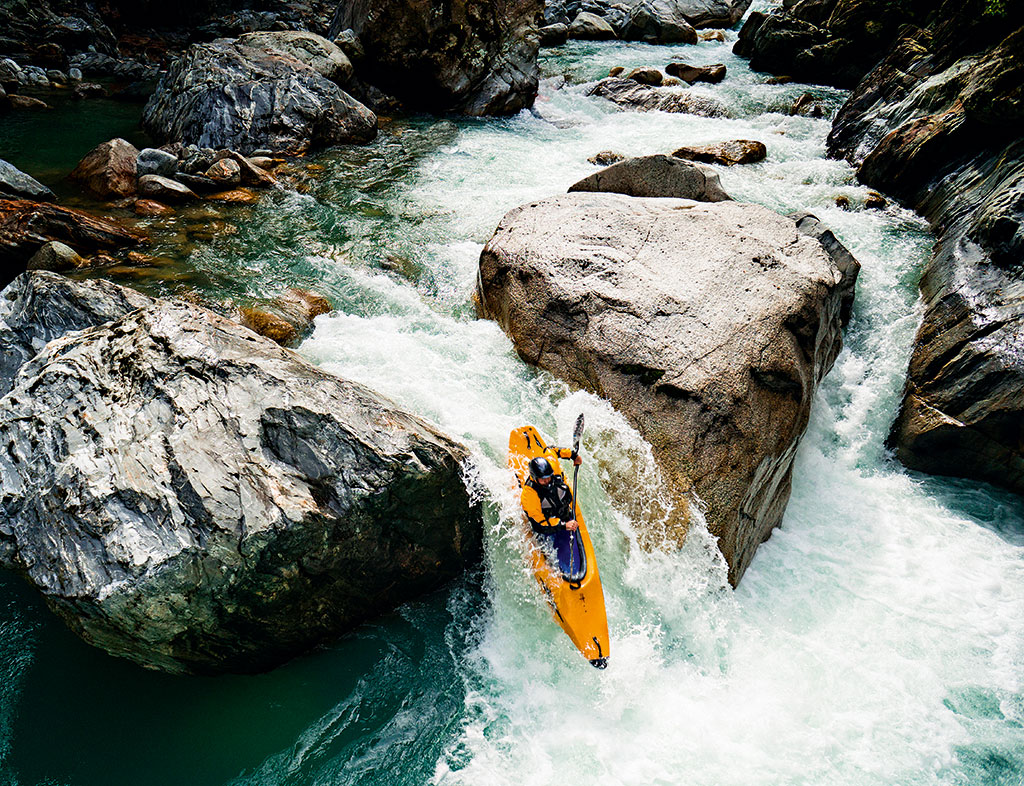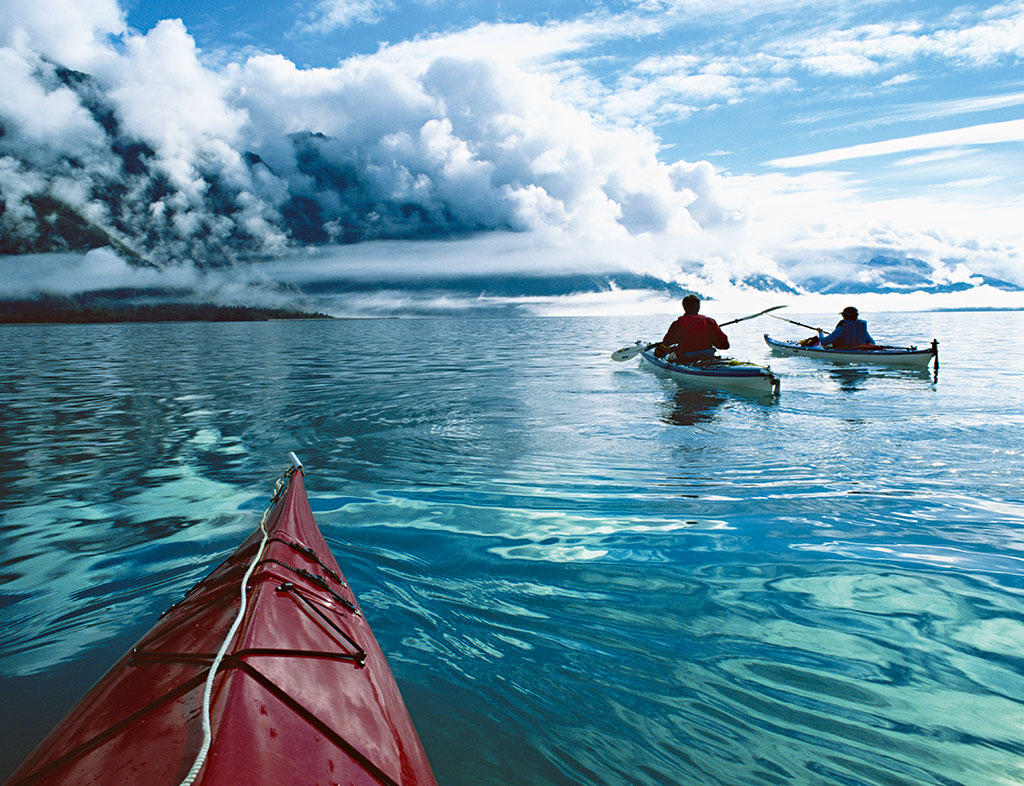Most people’s image of kayaking is a lone paddler, braving the cold as they crawl down a mid-town river, bordered by murky waters and discarded crisp packets. At first glance the hobby appears to offer little thrill for city types. But this perception is a world away from the reality of kayaking – tearing through whitewater at breakneck speeds or floating along sunlit coastlines a world away from home. The sport is without doubt one of the most versatile on earth.
The spear-like raft of the kayaker is believed to be over 6,000 years old. Originally developed by the Inuit and Aleut tribes of Arctic North America, the first kayaks were constructed from planes of driftwood or seal skin stretched taut over whalebone. Early paddlers would coat the kayak in whale fat to prevent water from streaming in, and attach air-filled seal bladders to keep the vessel afloat.
The sport is without doubt one of the most versatile on earth
Kayaking at first was not a hobby, but a way of life. It allowed locals to reach otherwise inaccessible resources and locations. Indeed, the kayak was such an integral part of everyday life back then that many used it – and still use it – as part of their burial ritual.
Going with the flow
Far from the boat’s beginnings spent on still waters, the kayak gradually made its way into stormier territory and came to be seen as a sport with its inclusion in the 1936 Berlin Olympics. From here the vessel of old underwent a series of integral changes to its construction, moving first to fibreglass in the fifties and later to polyethylene plastic in the eighties, as available materials became stronger, lighter and more streamlined. Over the same period kayaking moved away from the fringe and into the mainstream – today it features in 10 Olympic events.
“The best thing about kayaking is the places it takes you. I have travelled to five different continents with my kayak and have accessed places that you’d never be able to see without a boat,” says Sandra Hyslop, former European Champion and Junior Champion in whitewater racing, and nominee for Young Sports Personality of the Year, 2007. “I love the adrenaline rush of tackling hard whitewater and the sense of achievement after perfecting a line on a difficult rapid. I am also very competitive and very much enjoy racing in my kayak, although the vast majority of kayakers pursue this sport for purely recreational purposes.”
Not merely an Olympian’s pursuit, kayaking is practiced by people at all corners of the globe. Whether whitewater, slalom, sprint or polo, kayaking can be enjoyed by all, no matter your expertise or penchant for adventure.
Adrenaline rush
Split into eight primary classifications, kayaking can be loosely broken down into high and low intensity types. “Whatever the area you choose, there is always a strong learning curve as you learn to control and manoeuvre your boat and read whitewater,” says Hyslop. “One of the beauties of kayaking is that there is always something you can work on and improve, and even the best paddlers in the world have weaknesses they are constantly working on.”
Perhaps the most popular pursuit is whitewater kayaking, which typically takes place on a fast-moving body of water and asks paddlers to contend with strong currents. Whitewater kayaking is the most extreme version of the sport and takes many forms, among them river running, playboating and slalom, which each require a distinct set of skills and a taste for danger.

High-intensity kayaking satisfies a spectrum of adventurers; whereas some seek the rush that comes with kayaking off a waterfall, others wish to negotiate the narrow confines of a forest trail at speed. No matter the specifics, kayaking here is all about intensity, quick reflexes, the water in your face, and the kick that comes with making it through unscathed.
Sights and scenery
Nonetheless, many paddlers continue to opt for still waters. A world away from the blur that passes by on the whitewater trail, touring and expedition kayaking focuses on the scenery and the sheer enjoyment of absent-mindedly paddling past some quite incredible sights. This low-intensity alternative offers an opportunity to peer out into the wilderness from a unique vantage point.
Kayaking is steadily emerging as a choice corporate event for groups seeking something away from the typical office environment. Specialising in team building or competition exercises, a number of companies offer tailor-made deals for corporate types.
Whether it be the Nordics, South America or even the Arctic, kayaking’s diversity is best seen in the many places it can be practised. From the crystal-clear waters of Alaska’s Glacier Bay to the whitewater haven of Voss and Sjoa in Norway, kayaking is far from destination-specific.
Even the most uncompromising terrain provides opportunities for paddlers to test their skills. “Chile offers beautiful waterfalls and some challenging big-volume rivers down in Patagonia, whereas Ecuador has great river-running in warm water and through epic jungle,” says Hyslop.
Different directions
No matter the location, most places have a little bit of something for everyone and rarely cater for only one level of expertise. “The nice thing about kayaking is you can take it in so many different directions and stop whenever you reach your comfort level,” says Hyslop.
“Many kayakers will never paddle beyond flatwater but will take up sprint or marathon racing, fun touring on lakes and flat rivers, or kayak polo – an intense team sport played on lakes, or even in swimming pools. Others will be attracted to the adrenaline rush of whitewater and may take up slalom or downriver racing, freestyle paddling (throwing tricks on river features), ocean surfing or creeking (waterfall and steep river running).”
Whatever way you choose to take on the sport, kayaking can mean many different things to many different people. No matter your proficiency or thirst for adventure, there is something for everyone in this most diverse of sports. And Hyslop’s top tip? “Be prepared to get very wet, very frustrated, and ultimately exhilarated.”





